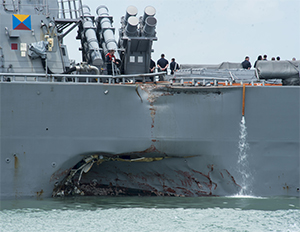The Navy announced in September that it will establish a new command to oversee training for the 7th Fleet. The creation of the Naval Surface Group Western Pacific follows fatal collisions involving two of the fleet’s Japan-based destroyers and a subsequent highly critical report by the Government Accountability Office.
The GAO found that USS John S. McCain and USS Fitzgerald, which collided with merchant ships earlier this year, had multiple missing certifications for warfare training. The chief of naval operations, Adm. John Richardson, responded that the Navy is creating a new command because the report indicated there was a pattern of waived training requirements throughout the 7th Fleet.
In written testimony to the Senate Armed Services Committee, Richardson said, “We have commenced a review of certifications of each ship, to include developing a plan for each to regain currency and proficiency across all certification areas.” He added that the commander of the Pacific Fleet will now approve all waivers for ships whose certifications have expired.
Richardson attributed his service’s readiness shortcomings to three factors beyond its control: The “corrosive confluence of high operational tempo, constrained funding levels and budget uncertainty.”
He said one step the Navy has taken to prevent future collisions was to have ships turn on their automatic identification systems in high-traffic areas. Under U.S. law, government vessels are not required to use AIS. “We had, I think, a distorted perception of operational security that we kept that system secure — off — on our warships,” Richardson said. “In heavily trafficked areas, we’re just going to turn it on.”
In his testimony to the committee, Secretary of the Navy Richard Spencer stated, “We have a problem in the Navy and we’re going to fix it.” He said Richardson’s comprehensive review would look at the “tactical and operational situation” while his “strategic readiness review” would be conducted by an independent team of military and industry experts that “will look at and examine root causes, accountability, long-term systemic issues, and then provide remedial insight.” The industry experts will include representatives from Maersk, Crowley Maritime Corp. and BP.
In an interview on CBS’ “Face the Nation,” Sen. John McCain, R-Ariz., chairman of the Armed Services Committee, blamed the collisions on budget caps. “It’s because of a thing called sequestration and our failure over the last eight years to make sure our military is prepared, equipped, trained,” McCain said. He later called for an immediate end to sailors working more than 100 hours a week — one of the findings of the GAO report — “that has been standard procedure for a long time.”
The guided-missile destroyer John S. McCain, named after the senator’s father and grandfather, collided with a tanker east of the Strait of Malacca and Singapore on Aug. 21. Ten sailors were killed and the destroyer sustained significant damage. McCain’s sister ship, Fitzgerald, almost sank off Japan after colliding with a Philippine containership on June 17. The bodies of seven sailors were found in a flooded berthing area.
In May 2015, the GAO reported that the Navy had increased the length of deployments, shortened training periods and reduced or deferred maintenance to meet high operational demands. This “has resulted in declining ship conditions and a worsening trend in overall readiness,” the agency said.
Since 2006, the Navy has doubled the number of ships based overseas, the GAO said. While this allows for rapid crisis response, the agency found that there were no dedicated training periods built into the operational schedules of the cruisers and destroyers based in Japan.
“As a result, the crews of these ships did not have all of their needed training and certifications. Based on updated data, the GAO found that, as of June 2017, 37 percent of the warfare certifications for cruiser and destroyer crews based in Japan — including certifications for seamanship — had expired,” the agency said. “This represents more than a fivefold increase in the percentage of expired warfare certifications for these ships since GAO’s May 2015 report.”
The Navy plans to revise operational schedules to provide dedicated training time, but this schedule has not yet been implemented, the GAO said.
The agency determined that reductions in crew sizes that the Navy made in the early 2000s may now be creating safety risks. “The Navy … continues to use a workweek standard that does not reflect the actual time sailors spend working and does not account for in-port workload — both of which have contributed to some sailors working over 100 hours a week,” the latest report said.
Last year, the GAO reported that the Navy was having difficulty completing maintenance on time. In the previous five years, maintenance delays had resulted in 6,603 days when the ships were not available for training and operations.
The agency said these problems will only get worse as the Navy tries to increase the size of its fleet by up to 30 percent. “These readiness problems need to be addressed,” the GAO said. “In addition, continued congressional oversight will be needed to ensure that the Navy demonstrates progress in addressing its maintenance, training, and other challenges.”

